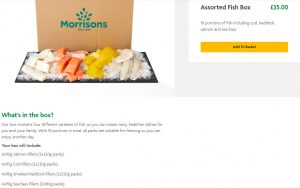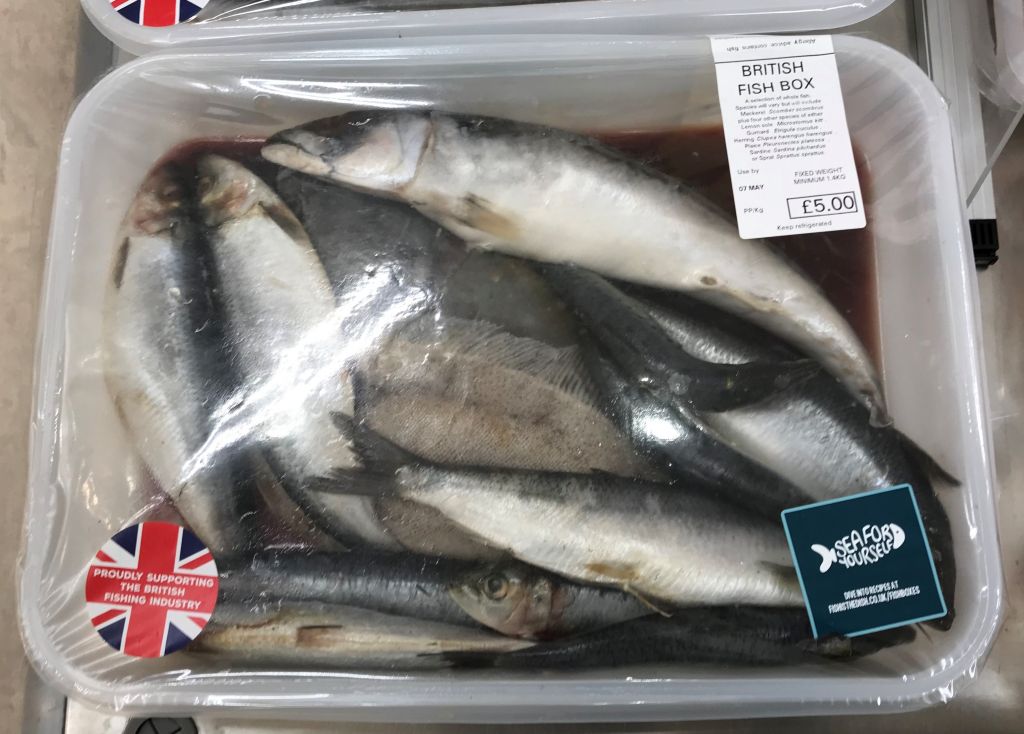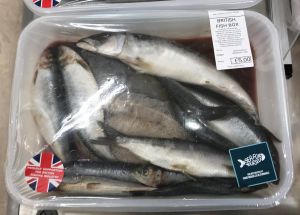Consuming issue: The arrival of coronavirus in the UK has exposed the extreme fragility of fish supply and fish consumption and when I say fish, I mean everything except salmon. Salmon has very much developed into its own protein group outside of fish in general. Salmon appears to have bucked the experience of the wider fish sector.
Home cooking and consumption of fish has been in decline for the last decade but the sector has not considered this to be a major issue because out of home consumption has been healthy, as have exports; that is until coronavirus hit the UK.
Overnight, the export market dried up and most restaurants and takeaways shut up shop over concerns about transmission of the virus. This left retail as the main outlet for fish. Anyone hoping that the public would make a swift transition to home cook fish would have been soon disillusioned after seeing supermarkets during the panic buying phase. Shelves were stripped of beef, pork, lamb and especially chicken leaving them totally bare. By comparison, packs of chilled fish were mostly ignored by shoppers and remained on the shelves. As the days passed, the range of fish on offer shrank as demand dried up. In part, this was due to the absence of older consumers, who would have been more receptive to buying a variety of species but were told to stay at home.
At the same time, most supermarkets took the decision to close all service counters including fish to free up staff to help with restocking shelves. Some counters found a new role!
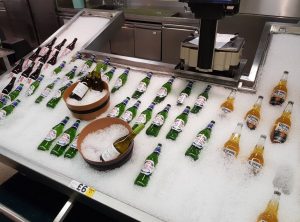
The closure of supermarket fish counters meant that what fish was being landed at British ports was competing for an even smaller share of market access. I remember seeing a tweet from a fisherman saying that he had some beautiful fresh pollock and that he was sure that if it could be displayed on a supermarket fish counter it would be snapped up. Sadly, the reality of the fish sector, regardless of coronavirus, would be that if this pollock did end up on a supermarket fish counter, then the likelihood would be is that is where it would remain.
The new world order of coronavirus means that it is easy to forget that supermarket fish counters had been shut long before the current pandemic. Asda had shut all its counters at the beginning of the year and Tesco had shut many of theirs later last year. They kept some open in response to an outcry about the closure of all their service counters.
Had we not had this pandemic; I suspect that we would have seen more counter closures in the coming months. Shoppers were not buying wet fish in sufficient numbers to justify keeping the counters open.
Of all the stores Waitrose endeavoured to reopen the counters within days whilst others have remained firmly shut. Morrisons have recently opened some counters as seafood bars with limited products.
Last week, the head of Seafood Scotland wrote to the CEO’s of Asda, Sainsbury’s, and Tesco to say that it is imperative that fish counters are re-opened to allow consumers access to fresh seafood from the domestic market. According to Fish Farmer, she said that ‘it is time for consumers to eat local, eat Scottish. We get to eat our own high quality, delicious healthy and sustainable seafood so that Scottish coastal communities can continue to operate’.
This is a very nice idea, but it is one that is far from reality. Many consumers no longer recognise fish and seafood as part of their normal daily home menu and not even a global pandemic is going to change this.
The writing has been on the wall for some time now. The industry in the UK has regularly held an annual promotion to persuade consumers to eat more fish. Seafood Week usually takes place in October and following the event in 2017, it was reported that there had been a media reach of 240 million views of the campaign. The social media campaign generated 51,431 unique users and there were 81 million impressions as part of the social stats. Overall, sales were up by 0.9% as a consequence of the promotion. At the same time, the DEFRA Family Food Statistics reported a fall in fish consumption from 144g per person per week to 136g. The message is not hitting home. The Industry 2040 strategy wants to see fish consumption double from the current one portion a week to the recommended two a week. This was unlikely to happen before the pandemic hit even though the target is twenty years away. Post coronavirus, two-a-week seems more remote than ever.
By coincidence. Fish Focus reports of a new campaign, ‘Sea For Yourself’, to urge consumers to eat more UK fish and shellfish. Although the campaign has clear messages for the current crisis as a way of helping British fishermen, the campaign was originally planned to coincide with the lighting of the Olympic flame on March 12th and is running until the end of May. The campaign has been orchestrated by DEFRA and they are working with Seafish. The campaign targets families and those aged over 55 to get them to eat more of the delicious seafood caught in British waters. Species highlighted include shellfish, mussels, oyster, crabs, and lobsters, oily fish such as mackerel, herring and rainbow trout and white fish such as hake, coley, monkfish and lemon sole.
The latest phase of the campaign began with advertising on Facebook and Instagram which is to be followed by radio and podcasts from chefs and local food heroes. According to Fish Focus, this activity represents an excellent opportunity for seafood businesses to engage with the campaign by sharing posts on social media with the aim of reaching more consumers, even though the evidence shows that such social media does not translate into increased consumption. One of the key influencers recruited to the campaign is Olympian Denise Lewis but a search of her Instagram account reveals just one posting about the campaign.
Fish Focus also reports that Morrisons supermarkets are aiming to capitalise on the ‘Sea For Yourself’ campaign by using the logo on their UK wild fish boxes. Sean Gill, the senior seafood buyer told Fish Focus that customers have said that they like our new ‘UK caught wild fish boxes’ and sales have surpassed expectations. Morrisons say that their focus on UK fish and the reopening of their fish counters will help customer to buy ‘home caught seafood’.
I saw my first Morrisons fish box last week. It did not appear to be a good advert for buying UK caught fish.
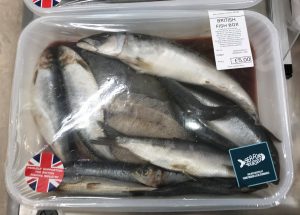
This selection of fish lying higgidly-piggidly in what looked like a soup of bloody water did not look especially appealing. It contained a variety of fish although what and how much was unclear. The label describes what could be in the box.
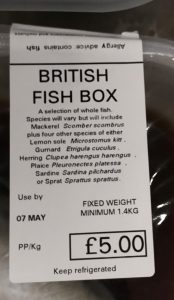
I returned to the store the following day and found new stock with a later date on display, which I bought.
The contents of the box can be seen to be one mackerel, one plaice, one lemon sole, four herring and six sardines.
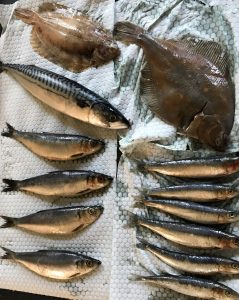
At £3.57/kg this selection of fish appears good value except I am not sure that the average Morrison’s customer will find it so. I think that I would struggle to want to eat these fish. They were all soft and the smell was not great and even though we know that many consumers are deterred from buying fish with heads, guts, fins and scales, these fish were as they had been caught. A fish aficionado might like this box, but I doubt whether most shoppers would even know what to do with it.
By coincidence, I saw a photo of another box on twitter that had been reduced to half price despite having two days left on the date. Another tweet I encountered showed a box reduced to just £1.50.
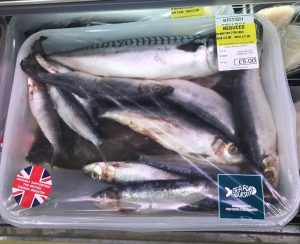
The reality is that whilst the intention is noble, consumers have become alienated from fish like these and a social media campaign will not encourage consumers to buy these species and certainly not in this form. I spoke to the fishmonger in Morrison’s who was not that enthusiastic about the fish boxes and who said that after initial interest, sales have declined. Certainly, there were only a couple of the boxes on display when I was last in store. The fishmonger also pointed out that all of the other fish on display was on offer at half price and thus was of more interest to those shoppers who wanted to buy fish. The counter was totally devoid of customers during my time in the store.
Back in 2014 and 2015, supermarket chain Sainsburys ran two campaigns called ‘Switch the Fish’ in which they wanted to encourage shoppers to try alternative species to the Big Five. Shoppers buying either cod, haddock, salmon, tuna, or prawns were offered a free portion of either mussels, trout, sea bass or coley to take home to try. Needless to say, Sainsbury’s have not repeated the campaign since and for good reason. The message was wrong. Effectively, shoppers were being told not to eat the fish they liked. If anything, this might deter shoppers from buying fish at all. It is not about which species to eat but to eat fish. Period.
The ‘Sea For Yourself’ campaign asks consumers to eat UK caught species but even if consumers are persuaded, there is a fundamental problem to overcome and that is identifying where consumers can actually buy these fish. Most supermarket do not stock many of the fish and for a simple reason. When they are available, they remain largely unsold because they are not species most consumers want. More importantly, they are not going to try them simply because social media is encouraging them to do so. I can only wonder when the sector is ever going to recognise that this whole approach requires a radical rethink.
Meanwhile, rather than look to supermarkets, this campaign would be an ideal opportunity to boost the awareness of local specialist fishmongers. Yet, at a time when the fishmongers could flourish, they too appear beset by problems. BBC TV Countryfile spoke to a fishmonger in Leicestershire who said he was having difficulty sourcing fish despite fishermen having fish to supply. Sadly, as I mentioned at the beginning, coronavirus has exposed the fragility of the fish sector.
Over the years, the rise of supermarkets has undoubtedly had an impact on local fishmongers. Seafood Source reported some years ago that during the 1940s that there were seven to eight thousand fishmongers in Britain. In 2014, the number was put at about 950 and it would not be surprising if it were now many less.
One of the things to come out of the coronavirus crisis is the apparent lack of connections within the fish and seafood sector. Hence, the fishmonger who appeared on the BBC Countryfile programme was bemoaning that he could not access fish to supply to his customers. He solved the supply problem by finding someone who drove up to Scottish ports twice a week to bring back stocks. What is clear from the current situation is that there needs to be a greater awareness of the supply chain from fishermen through to consumer. This is most apparent through the seeming lack of knowledge about independent fishmongers. With supermarket fish counters mostly closed, there have been attempts to link consumers to local fishmonger shops. A scheme highlighted in the Countryfile programme – ‘Call4Fish’- identified a supplier in Liverpool and one in Grange over Sands who might offer collection of delivery to Manchester where I am based. As Manchester is a major city, it might be expected that there ought to be several different fishmongers and suppliers ready to serve local consumers.
The website ‘Fish on Friday’ provides details of fishmongers and requests others to contact them to be listed. The map from their website shows a complete absence of anyone supplying fish from a massive are from Manchester to Birmingham and beyond.
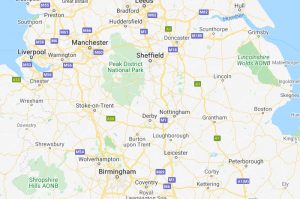
Fish is the Dish does slightly better with just one outlet in Manchester itself. There are others that are not included.

It does seem strange that there is not a database of every independent fishmonger in the country with details of where they are, what they supply, whether they deliver and more. Equally, there should be a database of suppliers that these fishmongers can access. Its not surprising that as the UK closed down, those parts of the sector that continued to function had no idea how to exploit those opportunities that started to appear.
Perhaps, if we want consumers to engage more with fish, we need to start at the grassroots. Its very easy for Morrisons to take up the baton for UK seafood through the ‘Sea For Yourself’ campaign but if every independent fishmonger had been recruited to the cause first, then perhaps it might have been a better approach than the current campaign. This will inevitably achieve absolutely nothing in terms of getting people to eat more fish let alone specific UK landed species.
Finally, it is worth noting that whilst Morrisons offer the fish box of wild caught fish as highlighted earlier, they also supply a wide range of other food boxes online. These range from meat, to vegetable and from Gluten free to BBQ. They also offer a fish box which is a completely different proposition to that available in stores. The Morrisons fish box includes 6 salmon fillets, 4 cod fillets 4 smoked haddock fillets and 4 sea bass fillets. The total weight of fish is 1920g and the box costs £35 equivalent to £18.23/kg. The fish is sourced from multiple areas, but all are likely to be from outside the UK except the salmon which could come from Scotland as well as Norway.
